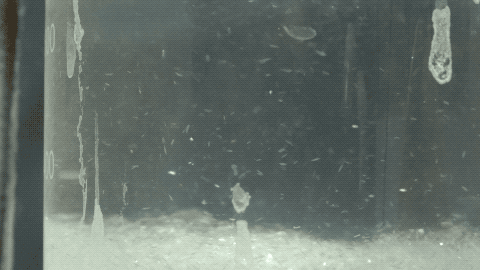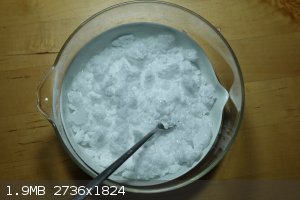metalresearcher
National Hazard
   
Posts: 758
Registered: 7-9-2010
Member Is Offline
Mood: Reactive
|
|
KClO3 or KClO4 after electrolysis ?
I electrolyzed 150g (2 mol) of KCl during 30 hours at 16 A, which is 480 Ah.
I stopped electrolyzing and the solution was 85-90C and filtered it. There was almost no precipitate, but might be some debris to filter off. The
filtrate crystallized nicely.

When cooled I put it into the fridge and let it cool to about 2 C and the next day I decanted off the solution, rinsed the crystals with ice cold
water and let them dry.
Then I electrolyzed the remaining solution for a few hours at 16 A but needed a higher voltage (9.5 V instead of 6.5 V) to get 16 A, probably less
concentrated.
But now I saw also gas escaping from the anode, which not occurred at the first run.
Is the salt solution now 'saturated' which means that all is now oxidized to KClO4 ?
How can I determine the difference between KClO3 and KClO4 ?
EDIT: A photo of the dried first batch.
[Edited on 2021-2-26 by metalresearcher]

|
|
|
Fery
International Hazard
    
Posts: 1018
Registered: 27-8-2019
Location: Czechoslovakia
Member Is Offline
|
|
Which material did you use for your electrodes?
|
|
|
metalresearcher
National Hazard
   
Posts: 758
Registered: 7-9-2010
Member Is Offline
Mood: Reactive
|
|
I used an MMO anode, have been using it for years successfully. Much better than carbon rods.
Tha cathode is an old stainless steel spoon, the cell is a 800ml glass peanut butter jar.
[Edited on 2021-2-26 by metalresearcher]
|
|
|
Johnny Cappone
Hazard to Self
 
Posts: 74
Registered: 10-12-2020
Location: Brazil
Member Is Offline
|
|
Quote: Originally posted by metalresearcher  |
I used an MMO anode, have been using it for years successfully. Much better than carbon rods.
Tha cathode is an old stainless steel spoon, the cell is a 800ml glass peanut butter jar.
[Edited on 2021-2-26 by metalresearcher] |
Graphite and MMO anodes will not give perchlorate, except traces. I read that there are MMO anodes capable of producing perchlorate, but I never heard
of anyone actually experimenting with them. There are specific tests for chlorate and perchlorate, you can check some of them at the link below.
However, a quick test is to drip two or three drops of concentrated sulfuric acid into a SMALL heap of crystals of the formed salt. Perchlorates will
not react visibly, chlorates will react with the formation of a white/yellowish mist and a noticeable Cl2/ClOx smell and the mixture will take on a
yellow to orange color, while a mixed sample will show results between the two extremes, depending of the prevalence of -ClO3 or -ClO4. It is
essential to carry out this experiment on the recommended scale, since larger volumes of the mixture can deflagrate. The resulting "broth" is a
powerful oxidizer, be careful in handling and disposal.
http://www.chlorates.exrockets.com/tests.html
|
|
|
ManyInterests
National Hazard
   
Posts: 930
Registered: 19-5-2019
Member Is Offline
|
|
Good that yo usucceeded. I made a cell similar to yours but it seems like I have not produced any chlorates. I am running mine at 4 amps because my
power supply doesn't go that high. Should I be using a smaller cell?
|
|
|
metalresearcher
National Hazard
   
Posts: 758
Registered: 7-9-2010
Member Is Offline
Mood: Reactive
|
|
Quote: Originally posted by ManyInterests  | | Good that yo usucceeded. I made a cell similar to yours but it seems like I have not produced any chlorates. I am running mine at 4 amps because my
power supply doesn't go that high. Should I be using a smaller cell? |
The size of the cell does not really matter, it is the current. There are lots of power supllies available, or even an old computer power supply
suffices.
Make the solution as concentrated as possible and keep it hot (at least 60-70 C) to allow oxidizing the ClO- (hypochlorite) to ClO3-. That can be
attained by ramping up the voltage or user larger electrodes. That also increases current and the 'waste' heat is actually used for electric heating
the solution.
[Edited on 2021-2-27 by metalresearcher]
|
|
|
ManyInterests
National Hazard
   
Posts: 930
Registered: 19-5-2019
Member Is Offline
|
|
Thanks for all the advice. I do see a lot of bubbling for hours on end after increasing the current as high as I could (4.4 amps and 4.15 volts.
That's as high as my power supply regulator will go) I could hook it up directly to my power supply, but I will have no idea how much current I am
passing, but if the input is anything to go by, it'll be 4 to 5 amps and 12 volts assuming full capacity.
The major issue is the heat. I have no idea how ot it is. It is much warmer than before, but I cannot tell how it is.
I'll keep it on for a few days, stir the solution and then turn it back on again, we'll see if I get any chlorates. The electrodes appear to be
holding up quite well though.
|
|
|
metalresearcher
National Hazard
   
Posts: 758
Registered: 7-9-2010
Member Is Offline
Mood: Reactive
|
|
Quote: Originally posted by ManyInterests  | Thanks for all the advice. I do see a lot of bubbling for hours on end after increasing the current as high as I could (4.4 amps and 4.15 volts.
That's as high as my power supply regulator will go) I could hook it up directly to my power supply, but I will have no idea how much current I am
passing, but if the input is anything to go by, it'll be 4 to 5 amps and 12 volts assuming full capacity.
The major issue is the heat. I have no idea how ot it is. It is much warmer than before, but I cannot tell how it is.
I'll keep it on for a few days, stir the solution and then turn it back on again, we'll see if I get any chlorates. The electrodes appear to be
holding up quite well though. |
Heat is not an issue at all, unless it rises above 80 C. When 60 C it is even better, as that will propagate the conversion of ClO- to ClO3-, lowers
resistance and thus allows more current in the same cell with the same electrodes. Put a thermometer in the solution. Get an ammeter as well, on
Amazon, ebay or even the local electronics shop volt / ampere meters are rather cheap.
Another idea is (never tried before, I have only one MMO anode): put two cells in series. Obviously, the concentration in both cells should be about
equal. You can ramp up the voltage twice with the same current. You only should check whether the voltage across each cell does not differ too much.
That makes twice the amount of chlorate in one timespan of running.
[Edited on 2021-2-28 by metalresearcher]
|
|
|
RustyShackleford
Hazard to Others
  
Posts: 200
Registered: 10-12-2020
Location: Northern Europe
Member Is Offline
|
|
MMO does not produce perchlorate, the reason for your voltage difference is dissolved KCl, it should always be saturated or near saturated for a cell
to work nicely
|
|
|
Tellurium
Hazard to Self
 
Posts: 84
Registered: 12-7-2017
Location: Group 16, Chalcogen City
Member Is Offline
Mood: smelly
|
|
As other people already said MMO doesn't produce perchlorate. But its fairly easy to test for Perchlorates. Just add a drop of 1% Methylene Blue
solution to your sample. If perchlorates are present this will produce a violet precipitate, which doesn't occur with chlorates. If you take solution
out of your cell you will need to boil it first to remove any chlorine or hypochlorite, as this destroys the Methylene Blue. But with KClO3/KClO4 you
can just use the crystals in water. However in your case this isn't really necessary.
|
|
|
metalresearcher
National Hazard
   
Posts: 758
Registered: 7-9-2010
Member Is Offline
Mood: Reactive
|
|
Quote: Originally posted by Tellurium  | | As other people already said MMO doesn't produce perchlorate. But its fairly easy to test for Perchlorates. Just add a drop of 1% Methylene Blue
solution to your sample. If perchlorates are present this will produce a violet precipitate, which doesn't occur with chlorates. If you take solution
out of your cell you will need to boil it first to remove any chlorine or hypochlorite, as this destroys the Methylene Blue. But with KClO3/KClO4 you
can just use the crystals in water. However in your case this isn't really necessary. |
Indeed.
I already ordered a platinized Ti anode for KClO4.
|
|
|
Tellurium
Hazard to Self
 
Posts: 84
Registered: 12-7-2017
Location: Group 16, Chalcogen City
Member Is Offline
Mood: smelly
|
|
Nice, I hope you didn't get ripped off, like I did. All of those cheap offerings on ebay for platinized Ti were actually just nickel strips. I got my
money back in the end, but they are still sold a lot. Probably because for a lot of applications(normal electrolysis in alkaline media, for example to
get HHO) you can't tell any difference. But when doing (per-)chlorate electrolysis they broke down. But you can easily tell it, because they are
magnetic, which both Ti and Pt shouldn't be.
I'm now using PbO2 on Titanium. They are like "the holy grail" of electrodes, as you can run them from chloride straight until perchlorate without
damaging the electrodes. With Pt you need to get rid of the chloride in the perchlorate cell or you will dissolve your electrodes. With KClO3/4 this
isn't difficult, as KClO3 will precipitate out easily, but especially with NaClO3/4 cells this makes it all way more easy!
|
|
|
ChemTalk
Hazard to Self
 
Posts: 65
Registered: 13-12-2018
Location: United States
Member Is Offline
Mood: colloidal
|
|
You could also check solubility. The solubility of KClO3 at 25C is 8 grams, for KClO4 it is just 1.5 grams.
---------------------------------------------------
ChemTalk
Chemistry Tutorials
[Edited on 3-5-2021 by ChemTalk]
|
|
|
ManyInterests
National Hazard
   
Posts: 930
Registered: 19-5-2019
Member Is Offline
|
|
Might as well drop the result of my chlorate cell after I took your advise on upping the current. I did it for several days before deciding to call it
a day and stopping the run. I managed to filter around 90 grams of chlorates with relatively little contamination, but the jar lid was heavily
corroded and I decided to get another glass container with a plastic snap-on lid to avoid this in the future.
The yield was pretty low, I did manage to separate the remaining chloride from the solution as well. I used up a lot of chloride for this run and I am
fairly disappointed at the very low amount I got after basically two weeks of running the cell. Hopefully my next run will be more successful. I will
try to keep the temp higher, too. I think my cell was around 40 or 50 C at the most, but I might end up putting my next one in a hot water bath to
keep it at 60 C. I might even drill another hole in the cell specifically to put in my thermometer.
|
|
|